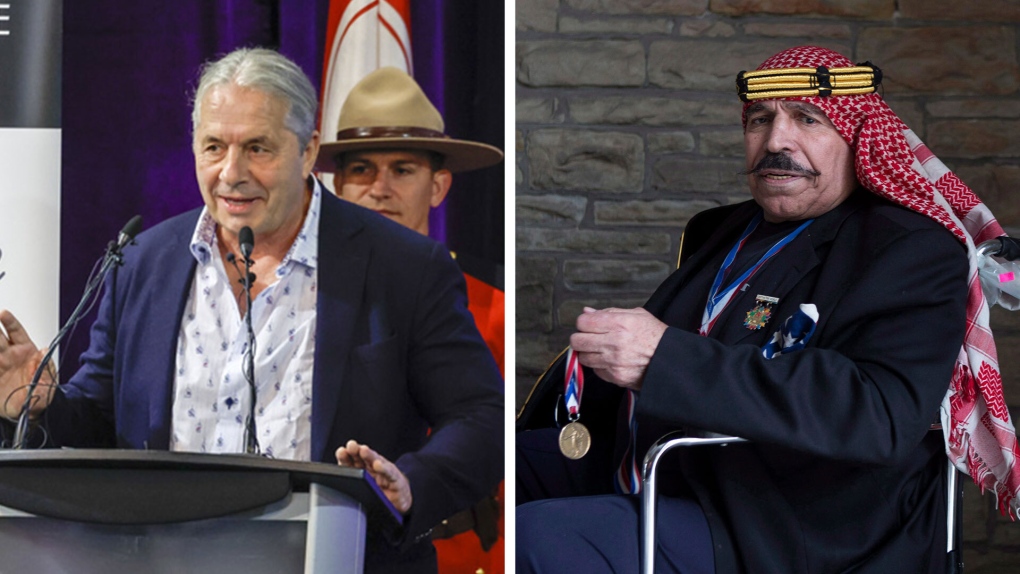‘He was a character,’ Canada’s Bret ‘Hitman’ Hart remembers the late Iron Sheik
Bret Hart’s longtime connection with the late Iron Sheik was first made in the early 1970s when an Iranian amateur wrestler — real name Hossein Khosrow Ali Vaziri — came to Calgary to learn from promoter Stu Hart.
It was in the infamous wrestling dungeon at the Hart family residence that promoter Stu — with teenage son Bret helping out — worked with the Iron Sheik to help him make the transition to the professional style.
“I was mostly just used as a practice dummy, but I got to be one of those guys that he trained with when he first started,” Hart said from Calgary. “When I met him years later in the WWF (now WWE) when he was really in his prime, he never forgot that I started with him.”
The Iron Sheik, who became one of sports entertainment’s biggest stars in the Hulkamania-fuelled mid-1980s, died Wednesday at 81, the WWE said.
“He treated me and often spoke of me like I was his student,” Hart recalled in an interview with The Canadian Press. “We had a great relationship because he had this start with me when he was nobody, when he was this young amateur wrestler and how I helped him.
“I always had that special relationship with him. He was a character.”
The Iron Sheik was competitive in Greco-Roman wrestling, competing in the Amateur Athletic Union and becoming a gold medallist in 1971, the WWE said.
In a documentary about his life called “The Sheik,” he said he once served as a bodyguard for the Shah. In the squared circle, he acknowledged taking advantage of anti-Iranian sentiment following the 1979 Iranian hostage crisis.
In 1983, the Iron Sheik won the WWF heavyweight title from Bob Backlund before dropping the belt to Hulk Hogan a few weeks later. He also won the promotion’s tag team championship in 1985 with Nikolai Volkoff at the first WrestleMania.
Hart, nicknamed “Hitman,” also became a star in the promotion as a tag team with Jim Neidhart and later as a solo performer. The Hart Foundation tag team wrestled the Iron Sheik and Volkoff on occasion.
“They always had a ton of heat because they had that Russian/Iran connection thing going,” Hart said. “It was always easy. For the lack of a better word, it was kind of cartoony.
“Like cartoon wrestling, it was so easy. There were good guys, bad guys and they were the total bad guys. It didn’t matter what happened.”
The Iron Sheik worked with Minnesota-based promoter Verne Gagne before heading north to Calgary. He later returned to Minneapolis and was soon on his way to working his gimmick — with the Camel Clutch as his finishing move — to great success.
“He wasn’t the greatest technical wrestler in pro wrestling terms,” Hart said. “He was often a guy that you had to wing it out there a little bit with him.
“He could ad-lib and at the same time he was a guy you could have a lot of laughs with (after).”
Hart’s late father, who ran the Stampede Wrestling promotion for decades, would often help develop athletes who had amateur wrestling, football or bodybuilding backgrounds.
“He would turn out these guys because he could pick their best qualities and show them what to do if they wanted to be professional wrestlers,” Hart said. “He always tried to toughen them up and show them what they needed to know (in) the ring.”
Hart said the Iron Sheik became arguably the most hated wrestler — ever — in the United States.
“He was actually a very pro-American guy in real life,” he said. “If you knew him, you knew what a good man he was. He had his good qualities. He was a real friend to the end and he was always a friend to me.
“I always had a love and respect for him. I know a lot of guys did.”
Hart worked as both a babyface and heel — a ‘good guy’ and ‘bad guy’ in wrestling parlance — at various stages of his career.
The heat generated from storylines — especially for someone with a hot character like the Iron Sheik’s — often made things challenging outside the ring, Hart said.
“It’s not easy for someone like him. It becomes very real,” he said. “People try to kill you and people try to run you off the road.”
Hart said there were occasional bomb threats at venues in those days. Sometimes people would be waiting outside the arena exit for the heel wrestlers at the end of the night.
“You could joke that it was all pro wrestling and everyone knows it’s a show but it was pretty serious stuff back then,” he said.
The Iron Sheik was inducted into the WWE Hall of Fame in 2005.
“Even right now I’m thinking of him pulling on his moustache and laughing about the escapades that him and Nikolai Volkoff got into going from one town to another,” Hart said with a chuckle.
“They were great characters and loved by everybody in the business.”
This report by The Canadian Press was first published June 8, 2023.
With files from The Associated Press
For all the latest Sports News Click Here

